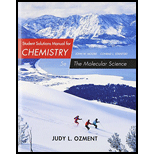
Concept explainers
For the reactions of molecular hydrogen with fluorine and with chlorine:
- (a) Calculate the enthalpy change for breaking all the bonds in the reactants.
- (b) Calculate the enthalpy change for forming all the bonds in the products.
- (c) From the results in parts (a) and (b), calculate the enthalpy change for the reaction.
- (d) Which reaction is most exothermic?

(a)
Interpretation:
The enthalpy change for breaking of all bonds present in all reactants of given reaction has to be calculated.
Answer to Problem 61QRT
The enthalpy change value for breaking of bonds for fluorine reaction is
Explanation of Solution
The reaction of molecular hydrogen with fluorine and chlorine is as follows,
Above both reactions, involves breaking of1
(b)
Interpretation:
The enthalpy change for forming of all bonds present in all products of given reaction has to be calculated.
Answer to Problem 61QRT
The enthalpy change value for forming of bonds in fluorine reaction is
Explanation of Solution
The reaction of molecular hydrogen with fluorine and chlorine is as follows,
Above both reactions involve formation of 2 hydrogen-halogen bonds. The
(c)
Interpretation:
The enthalpy change given reaction has to be calculated.
Concept Introduction:
The enthalpy change in a system
Where,
Answer to Problem 61QRT
The enthalpy change value for fluorine reaction is
Explanation of Solution
The reaction of molecular hydrogen with fluorine and chlorine is as follows,
The enthalpy change value for each reaction is determined by considering the formula,
(d)
Interpretation:
From the two given reactions, the exothermic reaction has to be identified.
Concept Introduction:
Enthalpy is the amount energy absorbed or released in a process. Under constant pressure conditions the enthalpy change will be equal to molar q.
Exothermic reaction: Exothermic reactions are those in which evolution of heat takes place during any chemical reaction. They release heat because the reactant molecules require less heat for breakage of bonds than the product molecules.
Endothermic reaction: Endothermic reactions are those in which heat is absorbed during any chemical reaction. In such type of reactions, external energy is needed.
Answer to Problem 61QRT
The reaction between molecular hydrogen and fluorine is more exothermic than the other one.
Explanation of Solution
The reaction of molecular hydrogen with fluorine is more exothermic since
Want to see more full solutions like this?
Chapter 4 Solutions
CHEMISTRY:MOLECULAR SCI.-STUD.SOLN.MAN.
- Hydrazine, N2H4, is a colorless liquid used as a rocket fuel. What is the enthalpy change for the process in which hydrazine is formed from its elements? N2(g)+2H2(g)N2H4(l) Use the following reactions and enthalpy changes: N2H4(l)+O2(g)N2(g)+2H2O(l);H=622.2kJH2(g)+12O2(g)H2O(l);H=285.8kJarrow_forwardHydrogen, H2, is prepared by steam reforming, in which hydrocarbons are reacted with steam. For CH4, CH4(g)+H2O(g)CO(g)+3H2(g) Calculate the enthalpy change H for this reaction, using standard enthalpies of formation.arrow_forwardThe enthalpy change for the reaction of hydrogen gas with fluorine gas (o produce hydrogen fluoride is 542 U for the equation as written: mg src=Images/HTML_99425-10-41QAP_image001.jpg alt="" align="top"/> l type='a'> What is the enthalpy change per mole of hydrogen fluoride produced? Is the reaction exothermic or endothermic as written? What would be the enthalpy change for the reverse of the given equation (that 1%, for the decomposition of HF into its constituent elements)?arrow_forward
- The equation for the fermentation of glucose to alcohol and carbon dioxide is: C6H12O6(aq) 2C2H5OH(aq) + 2CO2(g) The enthalpy change for the reaction is 67 kJ. Is this reaction exothermic or endothermic? Is energy, in the form of heat, absorbed or evolved as the reaction occurs?arrow_forwardWith a platinum catalyst, ammonia will burn in oxygen to give nitric oxide, NO. 4NH3(g)+5O2(g)4NO(g)+6H2O(g);H=906kJ What is the enthalpy change for the following reaction? NO(g)+32H2O(g)NH3(g)+34O2(g)arrow_forwardThe reaction of quicklime, CaO, with water produces slaked lime, Ca(OH)2, which is widely used in the construction industry to make mortar and plaster. The reaction of quicklime and water is highly exothermic: CaO(s)+H2O(l)Ca(OH)2(s)H=350kJmol1 (a) What is the enthalpy of reaction per gram of quicklime that reacts?. (b) How much heat, in kilojoules, is associated with the production of 1 ton of slaked lime?arrow_forward
- Chloromethane, CH3Cl, a compound found throughout the environment, is formed in the reaction of chlorine atoms with methane. CH4(g) + 2 Cl(g) CH3Cl(g) + HCl(g) (a) Calculate the enthalpy change for the reaction of CH4(g) and CI atoms to give CH3CI(g) and HCl(g). Is the reaction exo- or endothermic? (b) Draw an energy level diagram that shows how the various enthalpies in this problem are related.arrow_forwardNitrogen monoxide, a gas recently found to be involved in a wide range of biological processes, reacts with oxygen to give brown NO2 gas. 2 NO(g) + O2(g) NO2(g)rH = 114.1 kJ/mol-rxn Is this reaction endothermic or exothermic? What is the enthalpy change if 1.25 g of NO is converted completely to NO2?arrow_forwardEnthalpy of Reaction How much energy in kilocalories is emitted by the complete combustion of 386 g of isooctane (C8H18)? (Note: Hrxn=-36kJ/gC8H18.)arrow_forward
 Chemistry: The Molecular ScienceChemistryISBN:9781285199047Author:John W. Moore, Conrad L. StanitskiPublisher:Cengage Learning
Chemistry: The Molecular ScienceChemistryISBN:9781285199047Author:John W. Moore, Conrad L. StanitskiPublisher:Cengage Learning General Chemistry - Standalone book (MindTap Cour...ChemistryISBN:9781305580343Author:Steven D. Gammon, Ebbing, Darrell Ebbing, Steven D., Darrell; Gammon, Darrell Ebbing; Steven D. Gammon, Darrell D.; Gammon, Ebbing; Steven D. Gammon; DarrellPublisher:Cengage Learning
General Chemistry - Standalone book (MindTap Cour...ChemistryISBN:9781305580343Author:Steven D. Gammon, Ebbing, Darrell Ebbing, Steven D., Darrell; Gammon, Darrell Ebbing; Steven D. Gammon, Darrell D.; Gammon, Ebbing; Steven D. Gammon; DarrellPublisher:Cengage Learning Chemistry for Engineering StudentsChemistryISBN:9781337398909Author:Lawrence S. Brown, Tom HolmePublisher:Cengage Learning
Chemistry for Engineering StudentsChemistryISBN:9781337398909Author:Lawrence S. Brown, Tom HolmePublisher:Cengage Learning Introductory Chemistry: A FoundationChemistryISBN:9781337399425Author:Steven S. Zumdahl, Donald J. DeCostePublisher:Cengage Learning
Introductory Chemistry: A FoundationChemistryISBN:9781337399425Author:Steven S. Zumdahl, Donald J. DeCostePublisher:Cengage Learning Chemistry: Principles and PracticeChemistryISBN:9780534420123Author:Daniel L. Reger, Scott R. Goode, David W. Ball, Edward MercerPublisher:Cengage Learning
Chemistry: Principles and PracticeChemistryISBN:9780534420123Author:Daniel L. Reger, Scott R. Goode, David W. Ball, Edward MercerPublisher:Cengage Learning Chemistry & Chemical ReactivityChemistryISBN:9781133949640Author:John C. Kotz, Paul M. Treichel, John Townsend, David TreichelPublisher:Cengage Learning
Chemistry & Chemical ReactivityChemistryISBN:9781133949640Author:John C. Kotz, Paul M. Treichel, John Townsend, David TreichelPublisher:Cengage Learning





